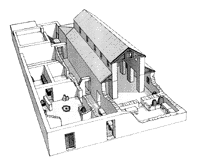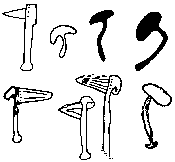| Contents
Abstracts |
Abstracts of Sahara volume 13
(published July 2002)
|
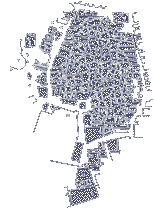
|
Timothy Insoll
The archaeology of post Medieval Timbuktu
ABSTRACT
Timbuktu, a city whose name is familiar to most, has only recently begun to be investigated systematically through archaeology. This paper presents the results of a programme of trial excavation which was completed in several parts of Timbuktu in September 1998. These excavations recovered assemblages of various types of archaeological material - pottery, tobacco pipes, beads, bracelets, metals, shell, glass, and spindle whorls. This material is considered and placed in context as regards the information it provides on trade and the history of the city between the eighteenth and twentieth centuries. Finally, a solution to the problems of completing archaeological research in Timbuktu and to assessing the origins of the city is proposed.
|
|
Top
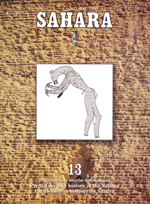
|
Steven E. Sidebotham and Willemina Z. Wendrich
Berenike: Archaeological fieldwork at a Ptolemaic-Roman port on the Red Sea coast of Egypt 1999-2001
ABSTRACT
Continued survey and excavation of the Ptolemaic-Roman (third century B.C.-sixth century A.D.) entrepôt of Berenike on the Red Sea coast of Egypt between 1999 and 2001 and on-going fieldwork in its environs greatly supplemented documentation obtained in 1994-1998. Long distance commercial contacts have been recorded between Berenike and the Persian Gulf, southern Arabia, India, Sri Lanka, the Kingdom of Axum, many areas of the Mediterranean basin, central Europe and the Near East. Possibly, too, indirect contacts extended as far as Afghanistan, Vietnam or Thailand and eastern Java. Floral and faunal remains and artifacts, including at least 11 different written languages, attest a wide variety of ethnic and linguistic groups involved not only in the “international” commerce, but also in the vibrant local and regional economies in which Berenike played such a pivotal role. While the Ptolemaic period (third-first centuries B.C.) was one of fairly extensive activity at the site, little evidence has come to light bearing on the port's long distance commercial contacts at that time. The peak periods of Berenike’s long distance trade were in early Roman (first century A.D.) and late Roman (mid-fourth to fifth centuries A.D.) times. The reasons for Berenike's ultimate, but gradual, demise are uncertain. Silting of its harbor, intense competition from the Kingdom of Axum and, possibly, a plague may have contributed to Berenike's final abandonment sometime before the middle of the sixth century A.D.
|
|
Top
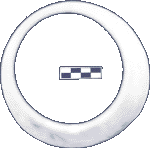
|
Maria Carmela Gatto
Two Predynastic pottery caches at Bir Sahara (Egyptian Western Desert)
ABSTRACT
In 1973 the Combined Prehistoric Expedition found at Bir Sahara, in the Egyptian Western Desert, two ancient caches with pottery vessels, some strange ceramic objects and clay rings. Close to them, an “Old Kingdom” site was noted. At the time, all this evidence was only briefly recorded and never studied in the following years. The aim of this paper is therefore a closer analysis of the ceramic material found at Bir Sahara, in order to place it in its right cultural context. The identification of Naqadian and A-Group pottery productions, both dated to the second half of the fourth millennium BC, seems to be related to the presence of the A-Group in the desert. This is also confirmed by new data from other desert areas, such as Laqiya. The Nubian territory was therefore not confined to the area along the Nile, but it extended also into the deserts on both sides of the river.
|
|
Top
|
Christian Dupuy, Philippe Fluzin, Alain Ploquin, Alain Durand et Christiane Rolando
Nouvelles données sur l’Age ancien des métaux au Mali
ABSTRACT
Our knowledge of the early Metal Age in Mali has recently been increased by new data concerning 72 engravings depicting silhouettes of bent objects in the rock art of the Adrar des Iforas region, and a slag-pit furnace found in an archaeological dig near the village of Koussané in the Kolimbine valley. The originality of the shapes suggests a local production. The association to motifs found int he rock art of the Adrar des Iforas and more northerly regions bears witness to the exchange, int he North-West of the continent, of valuable goods and of new world concepts from the West and the East Mediterranean countries in the second millennium B.C. The engravings of bent objects in the Adrar des Iforas probably date to this time, approximately a thousand years would thus seem to separate the first engraved representations of metallic objects in the Adrar des Iforas from the oldest known metallurgical remains found in archaeological digs in Mali. The furnace excavated at Koussané counts amongst the oldest remains. Its functioning is dated to the second-third centuries calibrated AD. It was used for direct reduction of iron ore rich in silica and was composed of a basin-shaped pit surrounded by a clay construction supporting at least four puddled clay tuyeres.
|
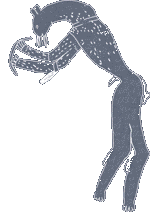
|
Adriana e Sergio Scarpa Falce
Uadi Sakallem (Tadrart Acacus): il “sito del dragone"
ABSTRACT
The rock painting described here is unique for its complex and indecipherable subject. The shelter, situated high above wadi Sakallem bottom, seems to be ideal as a sacred place. On the left, a few animals of the so-called “Large wild fauna” painted in a white silhouette and some human figures in the “Round head” style are heading towards an enigmatic painting depicting a series of ovoid segments surmounting a few therianthropes walking in the opposite direction. At least three therianthropes show rhino’s attributes and one of them has the head of a feline. From the latter’s nose a number of lines seem to indicate an epistaxis, rarely shown in Saharan paintings and for this reason a fact still baffling the authors. Nosebleed is reminiscent of south African art and is commented in various texts on eastern Africa and the sub-Saharan regions. However, if a connection with southern art exists, what does this exactly mean? The authors feel that speaking of shamanism or experiences of a primitive way of life is too simplistic. It must also be noted that two more paintings showing ovoid shapes are depicted in an adjacent shelter and in a small shelter situated not far from the site described here.
|
|
Top
|
Aldo Boccazzi e Donatella Calati
I pastori di Ourì
ABSTRACT
An astonishing coherent scene is painted in a rock art site of the Ouri region. It depicts a scene, in “Karnasahi style”, including 146 human figures that are split in two clearly distinct groups: one of herders, the other of hunters. This paper describes the scene and draws some conclusions about the kind of society that is depicted: a well-organised society with advanced social relationships allowing the organisation of such large meetings; an egalitarian society structure, as no human figure is represented with particular attributes; and a lay society, as no divinity symbol can be even inferred either in this painting or in others of the same style.
|
|
Top
|

http://www.saharajournal.com
e-mail: reception@saharajournal.com
Last update Monday, September 2, 2013
|
|
|
|




